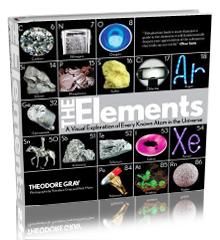Artificial knee joint (practice version). | |||
| Sample Image | Spin Video | QuickTimeVR Rotation | |||
| Artificial knee joint (practice version). After starting to collect elements I researched industrial uses of pure elements in search of products I might be able to get as samples. For titanium and tantalum a promising source seemed to be artificial body parts, since these are the only two elements used for that purpose, because they are unreactive with human body fluids. I joked to my long suffering colleagues that all I needed to do was find the right body to dig up. I think they were worried. And of course not two days later I found an eBay listing for a human tibia with attached artificial knee joint. (There is nothing you can't buy on eBay, though I'm told it's actually a femur so be sure to double check any human remains auctions before bidding.) The dealer seemed to be a legitimate outfit in Berkeley, California, and they indicated they thought it was probably titanium. I secretly hoped it was tantalum, which would have made it worth a serious amount of money. I won the auction for $31, which seems like a very fair price for half of someone's leg. (This would, by the way, set the price for an arm and a leg at approximately $120, a real bargain.) But doubt remained as to the true identity of the metal. According to the seller, this item had been made by the manufacturer of the artificial knee for use in training surgeons in the use of that company's special drills and tools. I hope they learned well, because it's got several cuts on it where it looks like someone slipped.... Since it was never meant to be implanted into a living person, I was worried they might have saved some money by using a cheaper alloy. I was right to worry. Through the good graces of Inga Karliner of the University of Illinois physics department I was put in contact with Ivan Petrov of the U of I's materials research department, which just happens to be a national collaborative center for materials testing, which means they have a hallway with something like two dozen very fancy instruments for telling me what my knee joint is made of. Dr. Petrov's colleague Jim Mabon confirmed my fears with a quantitative analysis by x-ray fluorescence spectroscopy: 99.78% Aluminum 0.109% Iron 0.0062% Nickel 0.0053% Copper 0.0257% Zinc In other words, common aluminum casting alloy. (Not only that, reader Don Keck tells me it's probably a femur, not a tibia, so the eBay description wasn't even right in that regard.) Interestingly, there was a 0.074% trace of titanium, which makes me think it was probably cast in the same mold, or maybe the aluminum was melted in the same crucible, as the titanium parts used on living people. There was not so much as the slightest detectable trace of tantalum. (Per the terms of their service, I should mention that this analysis was carried out in the Center for Microanalysis of Materials, University of Illinois, which is partially supported by the U.S. Department of Energy under grant DEFG02-91-ER45439.) Oh well, by then I'd become attached to my little bone, and it will have a place of honor under aluminum. After all, this was someone's leg, maybe someone's daddy's leg, and it deserves respect. (It is claimed to be a pre-1987 leg from India.) Source: The Bone Room Contributor: Theodore Gray Acquired: 13 May, 2002 Text Updated: 29 January, 2009 Price: $31 Size: 4" Purity: 99.78% Sample Group: Body Parts+Medical | |||
|

